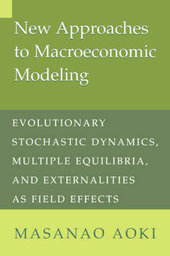
|
New Approaches to Macroeconomic Modeling: Evolutionary Stochastic Dynamics, Multiple Equilibria, and Externalities as Field Effe
Paperback / softback
Main Details
| Title |
New Approaches to Macroeconomic Modeling: Evolutionary Stochastic Dynamics, Multiple Equilibria, and Externalities as Field Effe
|
| Authors and Contributors |
By (author) Masanao Aoki
|
| Physical Properties |
| Format:Paperback / softback | | Pages:308 | | Dimensions(mm): Height 230,Width 153 |
|
| Category/Genre | Macroeconomics
Econometrics |
|---|
| ISBN/Barcode |
9780521637695
|
| Classifications | Dewey:339.015195 |
|---|
| Audience | | Professional & Vocational | |
|---|
| Illustrations |
9 Line drawings, unspecified
|
|
Publishing Details |
| Publisher |
Cambridge University Press
|
| Imprint |
Cambridge University Press
|
| Publication Date |
13 February 1998 |
| Publication Country |
United Kingdom
|
Description
This book contributes substantively to state-of-the-art macroeconomic modeling by providing a method for modeling large collections of heterogeneous agents subject to non-pairwise externality called field effects, i.e. feedback of aggregate effects on individual agents or agents using state-dependent strategies. Adopting a level of microeconomic description which keeps track of compositions of fractions of agents by 'types' or 'strategies', time evolution of the microeconomic states is described by (backward) Chapman-Kolmogorov equations. Macroeconomic dynamics naturally arise by expansion of the solution in some power series of the number of participants. Specification of the microeconomic transition rates thus leads to macroeconomic dynamic models. This approach provides a consistent way for dealing with multiple equilibria of macroeconomic dynamics by ergodic decomposition and associated calculations of mean first passage times, and stationary probabilities of equilibria further provide useful information on macroeconomic behavior.
Reviews"Economists are indebted to Masanao Aoki. He has done an excellent job in bringing together a large amount of important material on stochastic dynamics, showing economists how to use it, and presenting it all in a clear and readable manner. The examples which he presents are interesting but surely only scratch the surface of what these tools can do to improve the realism and depth of economic modeling, macro and micro." Ken Judd, Hoover Institution, Stanford University
|